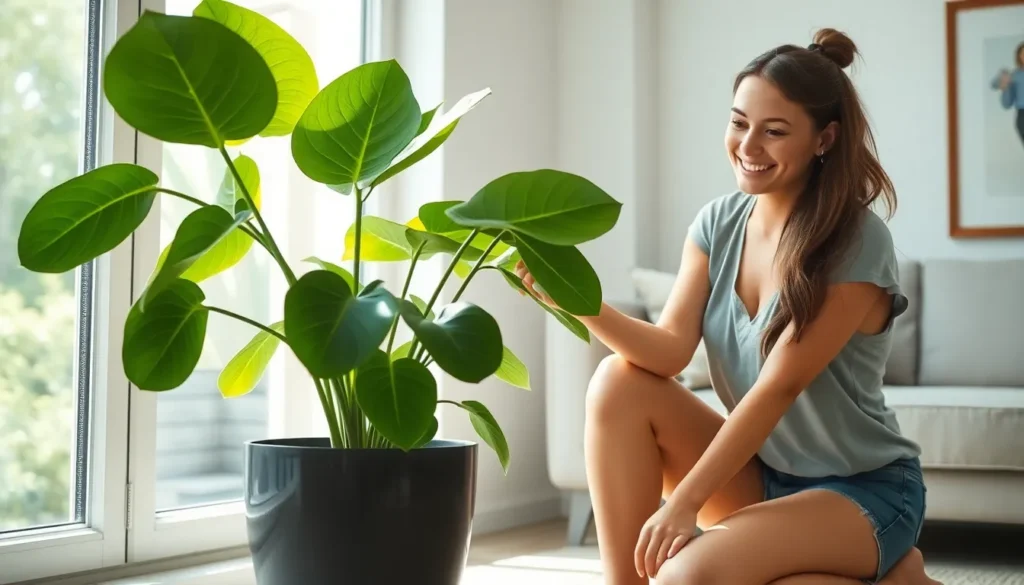We’ve all experienced that moment when we walk into a room and something feels off – the space lacks warmth, character, or that natural vitality that makes a house feel like home. Large potted plants can transform any indoor space from sterile to stunning, creating dramatic focal points that breathe life into your living areas.
These magnificent green giants don’t just add visual appeal; they’re powerhouse air purifiers that can improve your home’s atmosphere while making bold design statements. From towering fiddle leaf figs to sprawling monstera deliciosas, we’re seeing more homeowners embrace the trend of incorporating substantial greenery into their interior design schemes.
Whether you’re working with a spacious living room that needs a striking centerpiece or want to create natural room dividers, large indoor plants offer endless possibilities for elevating your home’s aesthetic. We’ll guide you through everything you need to know about selecting, caring for, and styling these impressive botanical beauties.
Choose the Right Location for Your Large Indoor Plants
Finding the perfect spot for your large potted plants can make the difference between thriving greenery and struggling foliage. We’ll guide you through the essential factors that determine where your impressive indoor plants will flourish best.
Consider Natural Light Requirements
Assess your home’s light patterns before selecting plant locations. Most large indoor plants like fiddle leaf figs require bright, indirect sunlight for 6-8 hours daily. Position these plants near south-facing or east-facing windows where they’ll receive consistent illumination without harsh direct rays.
Monitor seasonal light changes throughout the year since winter months reduce available sunlight by up to 50%. Plants near north-facing windows often struggle during darker months and may need supplemental grow lights. Rotate your plants weekly to ensure even growth and prevent them from leaning toward light sources.
Distance matters when placing plants near windows. We recommend positioning light-loving varieties 3-5 feet from bright windows to avoid leaf burn while ensuring adequate exposure.
Evaluate Floor Space and Ceiling Height
Measure your available floor area before bringing home that statement monstera deliciosa. Large potted plants typically need 3-4 feet of clearance on all sides for proper air circulation and growth. Account for mature size since many popular varieties like rubber trees can reach 6-10 feet indoors.
Check ceiling heights to accommodate your plant’s full growth potential. Standard 8-foot ceilings work well for most large houseplants, but varieties like bird of paradise may require 10-foot clearances. Consider growth patterns when selecting locations since some plants spread horizontally while others grow primarily upward.
Plan for pot proportions as large plants often require substantial containers. A 6-foot fiddle leaf fig typically needs an 18-24 inch diameter pot, which adds considerable width to your space requirements.
Account for Temperature and Humidity Levels
Maintain consistent temperatures between 65-75°F for optimal plant health. Most large indoor plants suffer when exposed to temperature fluctuations near heating vents, air conditioning units, or drafty windows. Avoid placement within 3 feet of heat sources or cooling systems that create extreme temperature variations.
Monitor humidity levels since indoor environments typically range from 30-50% humidity while tropical plants prefer 50-60%. Bathrooms and kitchens naturally provide higher humidity levels that benefit moisture-loving varieties. Group plants together to create beneficial microclimates that increase local humidity through transpiration.
Test air circulation in potential locations since stagnant air promotes fungal issues and pest problems. Gentle air movement from ceiling fans or natural ventilation helps prevent these issues while supporting healthy plant metabolism.
Select Low-Maintenance Large Indoor Plants for Beginners
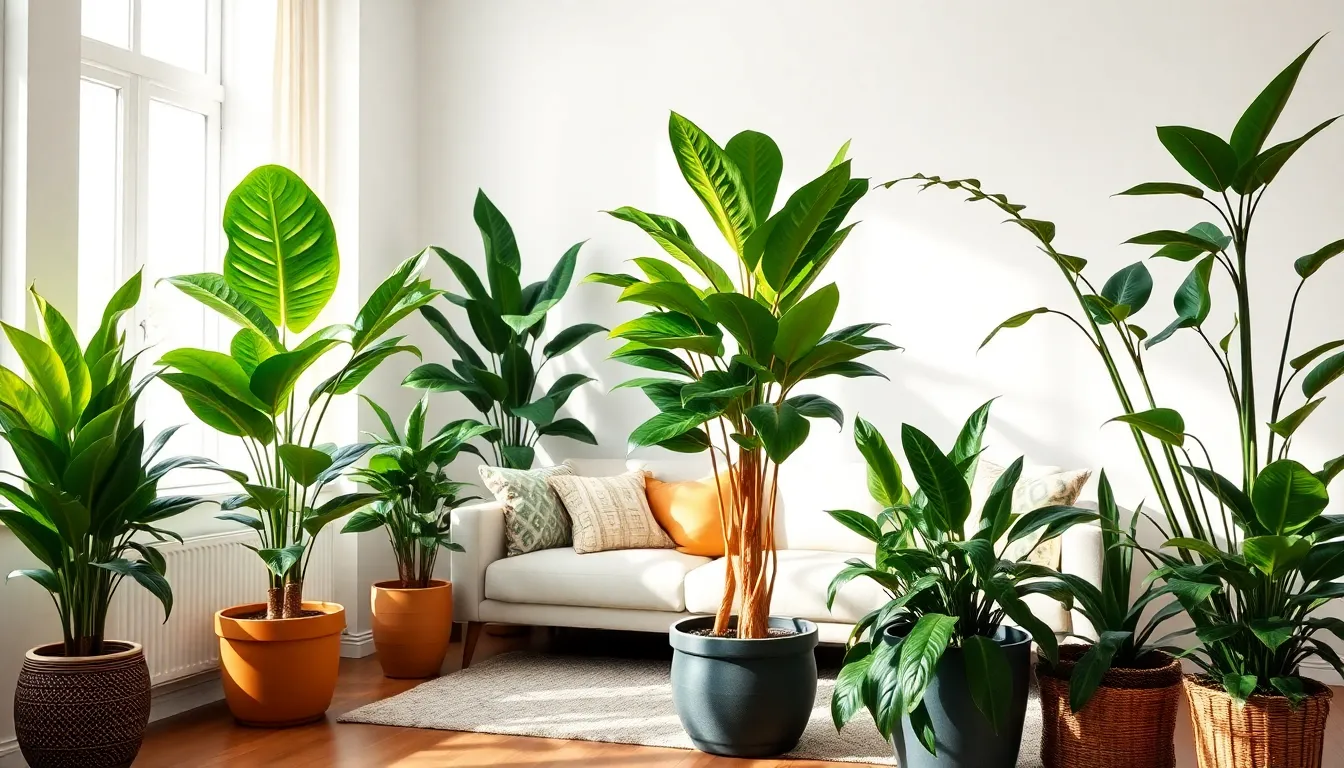
We’ve found that beginners often succeed with forgiving varieties that tolerate occasional care lapses while still making dramatic visual statements.
Fiddle Leaf Fig Trees
Fiddle Leaf Fig trees deliver striking vertical growth with their large, dramatic leaves that create impressive focal points in any room. These Ficus lyrata specimens require moderate to bright indirect light and benefit from consistent watering when the top inch of soil feels dry. While they’re slightly more sensitive than other beginner options, we’ve observed that consistent care routines help them thrive indoors. Their broad, sculptural foliage adds instant sophistication to living spaces, making them excellent choices for those willing to establish regular maintenance habits.
Rubber Plants
Rubber Plants offer exceptional forgiveness with their broad, glossy leaves and naturally upright growth pattern. These Ficus elastica varieties tolerate moderate light conditions and handle occasional watering schedules without distress. We particularly appreciate their ability to add both height and visual interest while requiring minimal intervention. Their resilient nature makes them perfect for beginners who want dramatic impact without complex care requirements, and their adaptability to various indoor environments ensures long term success.
Snake Plants and Dracaenas
Snake Plants feature tall, stiff leaves that make them extremely drought tolerant options for novice plant parents. These Sansevieria varieties thrive in low light conditions and prefer well drained soil, making them ideal large indoor plants for minimal maintenance routines. They’re perfect for beginners who may forget regular watering schedules since they actually prefer infrequent water applications.
Dracaenas showcase slender, arching leaves in varieties like Dracaena marginata that adapt beautifully to indoor conditions. These plants prefer moderate indirect light and infrequent watering while tolerating some neglect, which makes them excellent choices for those new to houseplant care. Their graceful form adds elegant height to spaces while requiring minimal attention to flourish.
Invest in Proper Drainage and Pot Selection
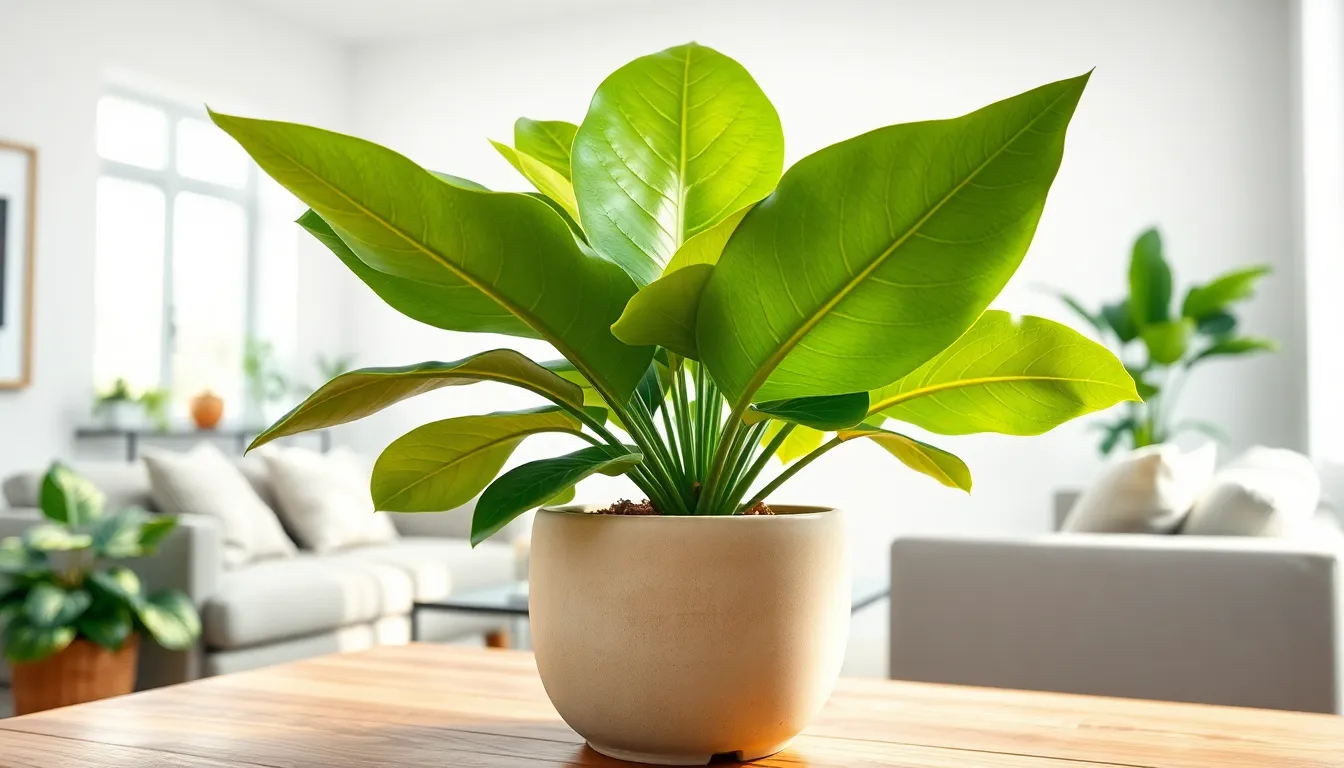
Proper drainage and thoughtful pot selection form the foundation of successful large indoor plant care. We’ll ensure your investment thrives by focusing on these critical container considerations.
Choose Pots with Adequate Drainage Holes
Large indoor plants require containers with sufficient drainage holes to prevent water accumulation at the bottom. Water should flow freely through these holes when we irrigate our plants, ensuring excess moisture doesn’t damage the root system. Root rot becomes a serious threat when water sits stagnant in containers without proper drainage pathways.
We recommend testing drainage by watering until liquid flows out of the bottom holes. This practice confirms our drainage system works effectively and prevents waterlogged soil conditions. Multiple drainage holes work better than single openings for large containers since they distribute water flow more evenly.
Consider Pot Material and Weight Distribution
Pot materials significantly impact both stability and maintenance requirements for our large indoor plants. Ceramic and clay containers provide excellent stability for tall plants like fiddle leaf figs and rubber plants, preventing dangerous tipping incidents. These heavier materials distribute weight evenly across the base, accommodating extensive root systems without compromising balance.
Plastic containers offer easier handling and mobility but require additional weight considerations for larger plants. We often need to add decorative stones or use plant stands to prevent lightweight containers from becoming unstable. Metal containers provide durability but may conduct temperature changes that affect root health in certain environments.
Select Appropriate Pot Sizes for Plant Growth
Large plants need containers that accommodate their extensive root systems without overwhelming them with excessive soil volume. We should choose pots slightly larger than the current root ball to allow growth space while maintaining proper moisture control. Oversized containers retain too much water and can lead to root problems in our prized specimens.
Repotting becomes necessary when roots appear through drainage holes or when plants become top heavy in their current containers. We monitor our large indoor plants for these signs and plan container upgrades accordingly. Proper sizing supports healthy growth patterns while maintaining manageable care routines for our indoor plant collections.
Master the Watering Schedule for Large Potted Plants
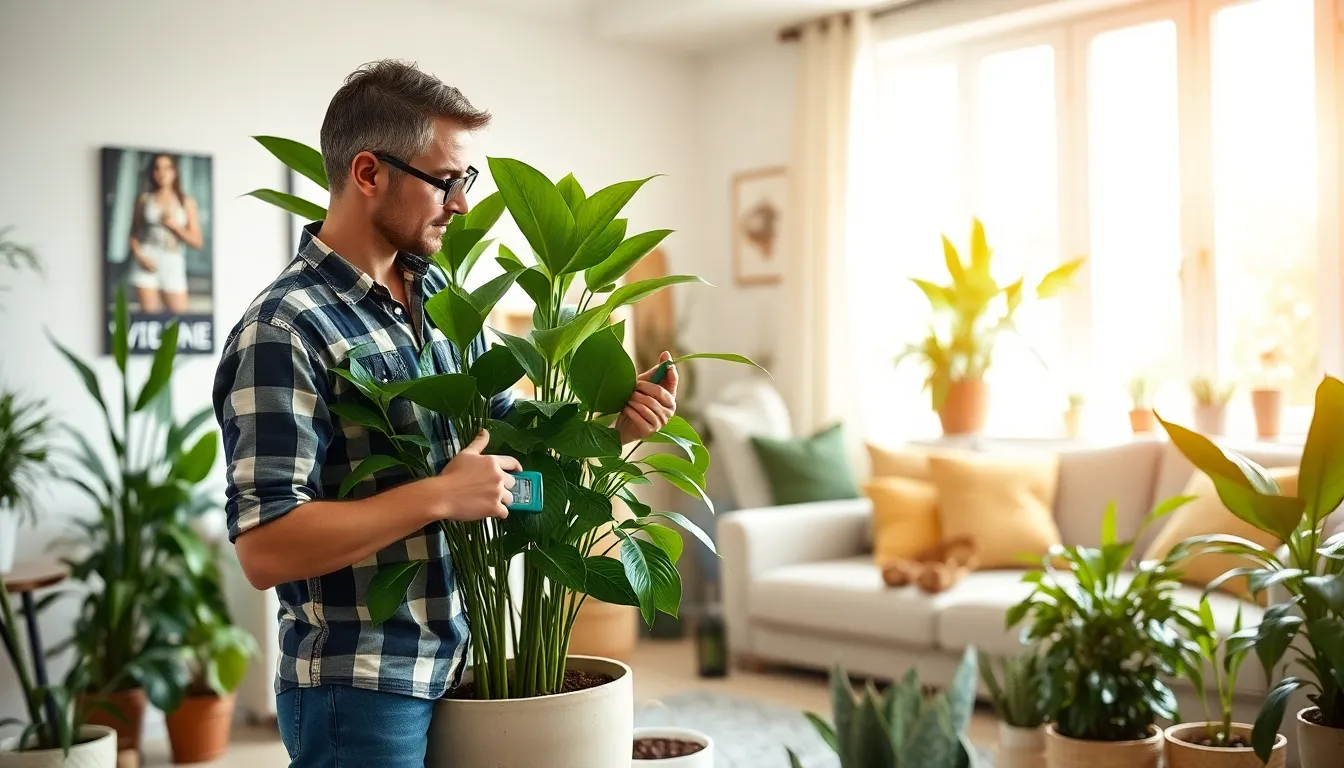
We need to approach watering large indoor potted plants differently than their smaller counterparts. Large plants in bigger containers retain moisture longer because their substantial soil volume acts as a natural reservoir, typically requiring watering only once a week to once every four weeks depending on the species.
Understand Soil Moisture Testing Methods
Testing soil moisture accurately prevents both overwatering and underwatering disasters in our large indoor plants. We recommend the simple finger test as our primary method: insert your finger 1-2 inches deep into the soil and water only when it feels dry at that depth.
Moisture meters offer precision without disturbing plant roots, making them ideal for valuable or sensitive large specimens. These digital tools eliminate guesswork and provide consistent readings across all our indoor plants.
Visual cues also help us assess moisture levels effectively. Dark, moist soil indicates adequate water content, while light-colored, pulling-away-from-pot-edges soil signals dryness.
We should aim for evenly moist soil rather than soggy or bone-dry extremes. Each plant species has exact moisture preferences, so we’ll adjust our testing frequency accordingly.
Establish Seasonal Watering Adjustments
Seasonal changes dramatically affect how often we water our large indoor potted plants throughout the year. Winter months require significantly less water because plant growth slows and indoor evaporation rates decrease naturally.
Spring and summer bring increased watering demands as our plants enter active growing seasons. We’ll need to monitor soil moisture more frequently during these warmer months when plants consume water rapidly.
Indoor environmental factors also influence our watering schedule adjustments. Brighter, warmer locations increase water needs, while cooler, dimmer spots extend time between waterings.
We should track seasonal patterns for each plant species in our collection. Snake plants might need water every three weeks in winter but weekly during summer growth spurts.
Recognize Signs of Overwatering and Underwatering
Overwatering symptoms appear as yellowing leaves, soft or wilting foliage even though moist soil, and moldy surface growth on potting mix. Root rot becomes a serious risk when we see these warning signs consistently.
Underwatering manifests through dry, brittle leaves with brown tips and overall plant wilting from dehydration stress. These symptoms develop gradually, giving us time to adjust our watering routine.
We must monitor our large indoor plants regularly to catch these issues early. Quick identification allows us to modify watering frequency before permanent damage occurs.
Recovery strategies vary based on the problem: overwatered plants need improved drainage and reduced watering, while underwatered specimens require gradual moisture restoration rather than flooding.
Provide Adequate Nutrition Through Fertilizing
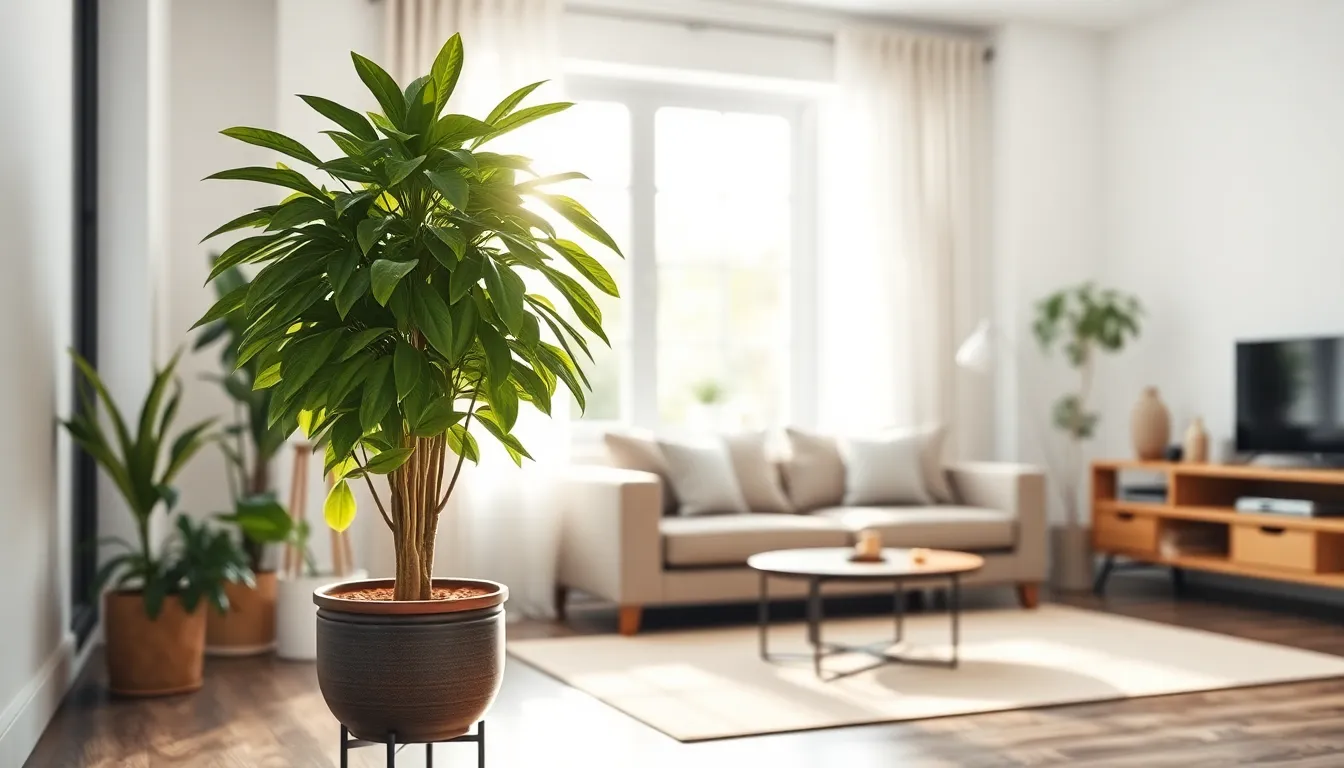
Large indoor plants need consistent nutrition to maintain their impressive size and lush appearance throughout the growing season. We’ll explore the essential aspects of feeding these substantial plants to keep them thriving in our homes.
Choose the Right Fertilizer Types
Balanced fertilizers containing equal parts nitrogen, phosphorus, and potassium work best for most large houseplants. Formulations like 10-10-10 deliver the essential macronutrients needed for healthy leaf development, strong root systems, and overall plant vigor.
Liquid fertilizers offer precise control over nutrient delivery and mix easily into our regular watering routine. Water-soluble options dissolve completely in water and provide immediate nutrition that plants can absorb quickly through their root systems.
Slow-release pellets provide steady nutrition over several months as we water our plants regularly. These granular fertilizers break down gradually, reducing the frequency of feeding while maintaining consistent nutrient availability.
Organic alternatives like compost or worm castings can be worked into the topsoil for gentle, long-term nutrient release. Natural options feed beneficial soil microorganisms while providing steady nutrition without the risk of chemical buildup.
Specialized formulas target exact plant needs depending on growth patterns and flowering habits. High-nitrogen blends promote leafy growth in foliage plants, while phosphorus-rich mixtures support flowering species during their blooming periods.
Follow Proper Fertilizing Schedules
Monthly feeding during the active growing season from March through September keeps large potted plants well-nourished. Most indoor plants experience their peak growth during these warmer months and require regular nutrient supplementation.
Winter feeding should be reduced or paused completely as plant growth naturally slows in cooler temperatures. Dormant plants process fewer nutrients and can suffer from fertilizer buildup if we continue regular feeding schedules.
Low-light environments require less frequent fertilization, typically only 2-3 applications per year. Plants receiving minimal natural light grow more slowly and need proportionally fewer nutrients to maintain their health.
Product label instructions provide exact dilution rates and application frequencies that prevent over-fertilization. Following manufacturer guidelines protects plant roots from salt damage and nutrient burn that can occur with excessive feeding.
Monitor Plant Response to Feeding
Healthy new growth and vibrant leaf color indicate that our fertilization program is working effectively. Well-fed plants produce fresh foliage with rich coloring and maintain strong, upright growth patterns throughout the growing season.
Yellowing leaves or brown leaf tips often signal fertilizer problems that require immediate attention. Over-fertilization causes salt buildup in the soil, while under-fertilization leads to nutrient deficiencies that manifest as discolored foliage.
Wilting even though adequate watering can indicate root damage from excessive fertilizer concentration. Salt accumulation in the soil draws moisture away from plant roots, creating drought-like conditions even in properly watered containers.
Adjusting fertilizer strength and frequency based on plant responses ensures optimal nutrition without causing stress. We can reduce application rates for sensitive plants or increase feeding for vigorous growers that show signs of nutrient hunger.
Maintain Your Large Indoor Plants Through Regular Care

Consistent maintenance routines keep our large indoor plants healthy and visually stunning throughout the year. These essential care practices ensure our plants continue thriving while improving our indoor spaces.
Carry out Proper Pruning Techniques
Remove dead or yellowing leaves promptly to maintain your plant’s health and appearance. We should inspect our large indoor plants weekly for any damaged foliage that’s draining energy from healthier parts.
Trim back overgrown sections carefully using clean, sharp pruning shears to prevent disease transmission. Strategic pruning helps redistribute the plant’s energy to more vigorous areas while maintaining an attractive shape.
Encourage bushier growth by pinching or cutting just above leaf nodes where new shoots can emerge. This technique promotes fuller, more balanced development in plants like rubber trees and fiddle leaf figs.
Shape your plants attractively by removing branches that cross or grow inward toward the center. Regular pruning keeps large specimens manageable while preventing them from becoming too unwieldy for indoor spaces.
Clean Leaves for Optimal Photosynthesis
Dust accumulation hinders photosynthesis and reduces your plant’s ability to absorb light efficiently. We need to clean large leaves regularly since dust particles block the surface area needed for proper light absorption.
Use a damp cloth to wipe leaves gently starting from the base and moving toward the tip to avoid tearing delicate foliage. Microfiber cloths work particularly well for this task without leaving streaks or residue.
Apply gentle spray methods for plants with many small leaves that are difficult to wipe individually. Lukewarm water in a spray bottle effectively removes dust and grime without shocking the plant.
Maintain vibrant, healthy appearance by cleaning both the top and bottom surfaces of leaves where dust commonly settles. Clean leaves not only photosynthesize better but also look more attractive in our living spaces.
Rotate Plants for Even Growth
Large indoor plants grow unevenly toward light sources creating lopsided or leaning specimens over time. We should rotate our plants regularly to ensure all sides receive adequate light exposure.
Turn plants a quarter turn weekly to promote balanced development and prevent one side from becoming significantly larger than others. This simple practice maintains symmetrical growth patterns.
Prevent leaning or lopsided growth by monitoring which direction your plant naturally bends and adjusting its position accordingly. Plants that consistently lean toward windows need more frequent rotation.
Ensure all sides receive light evenly by marking pots with small indicators to track rotation schedules. Consistent rotation promotes uniform foliage density and prevents sparse growth on shadier sides.
Address Common Problems with Large Indoor Plants
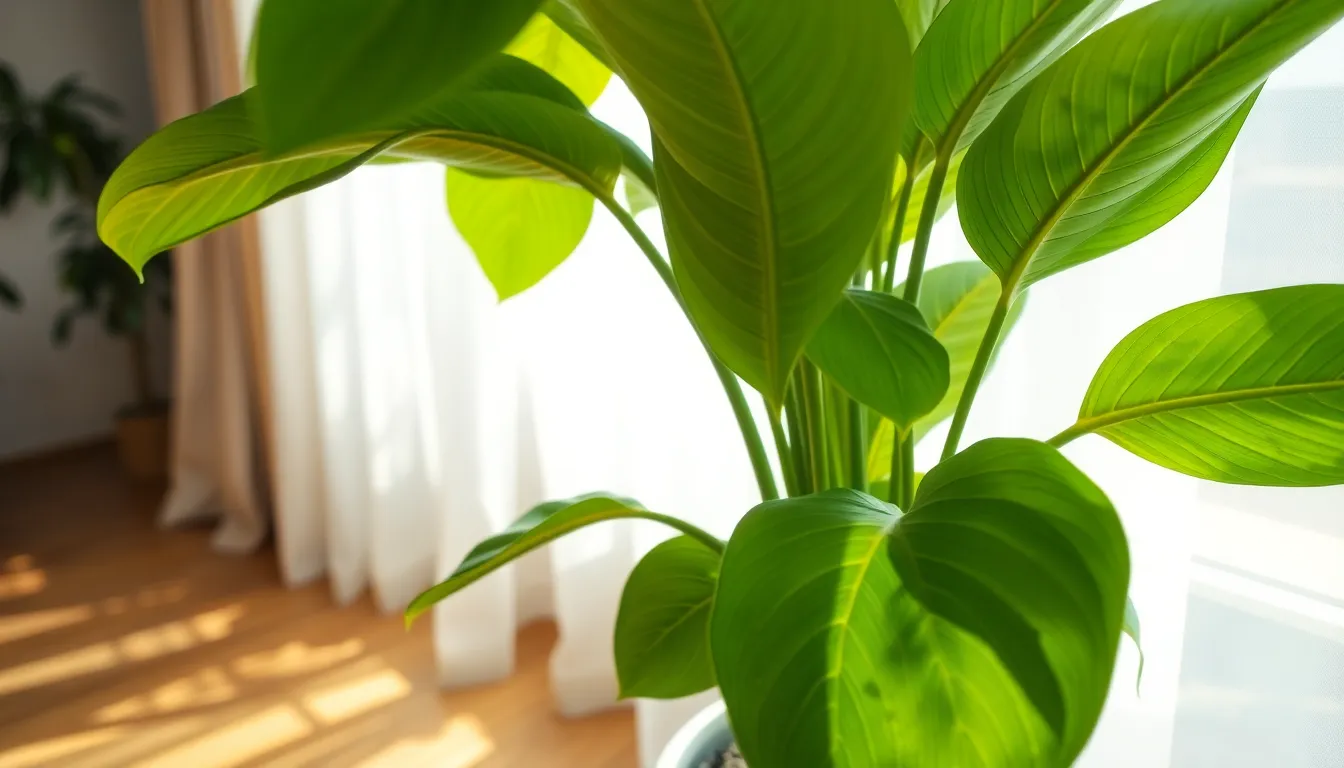
Even with consistent care, we’ll occasionally encounter challenges with our large indoor plants. Understanding how to identify and solve these common issues quickly helps maintain our plants’ health and beauty.
Identify and Treat Pest Infestations
Spider mites, aphids, scale, and mealybugs are the most common pests that target large indoor plants. We need to inspect our plants regularly since larger foliage provides more hiding spots for these unwelcome visitors.
Check the undersides of leaves during our weekly maintenance routine, as this is where most pests prefer to hide. Look for yellowing leaves, sticky residue on surfaces, or visible bugs crawling on stems and foliage.
Isolate infested plants immediately to prevent pests from spreading to our other greenery. Move affected plants to a separate room or area away from healthy specimens.
Treat early infestations with insecticidal soap or neem oil, which are gentle yet effective answers. Spray all leaf surfaces thoroughly, paying special attention to undersides and stem joints where pests congregate.
Apply treatments consistently every 5-7 days until we see no signs of pest activity. Severe infestations may require stronger pesticides, but we should always start with the gentlest approach first.
Manage Yellowing or Dropping Leaves
Overwatering ranks as the primary cause of yellowing leaves in large indoor plants, followed closely by underwatering and insufficient light. We can distinguish between these issues by examining the soil moisture and leaf patterns.
Check soil moisture by inserting our finger 2-3 inches deep into the potting mix. Soggy soil indicates overwatering, while bone dry soil suggests we need to water more frequently.
Adjust our watering schedule based on what we discover during soil checks. Large plants typically need watering every 1-4 weeks, depending on the species and environmental conditions.
Evaluate light conditions if watering isn’t the culprit, since insufficient brightness weakens plants and causes leaf yellowing. Even low light tolerant varieties like Snake Plants perform better with bright, indirect illumination.
Remove yellowed leaves promptly by cutting them at the base with clean scissors. This prevents the plant from wasting energy trying to revive damaged foliage.
Monitor for nutrient deficiencies that also manifest as yellow leaves, particularly if we haven’t fertilized recently or notice the yellowing affects older leaves first.
Handle Root-Bound Situations
Root bound plants show slowed growth and roots that circle tightly inside their containers, restricting proper nutrient and water uptake. We’ll notice roots growing through drainage holes or visible on the soil surface.
Schedule repotting every 1-2 years for most large indoor plants, or sooner if we observe root bound symptoms. Spring provides the ideal timing since plants recover faster during their active growth period.
Choose a container that’s only 1-2 inches larger in diameter than the current pot. Oversized pots hold too much moisture and can actually harm our plants.
Gently loosen circling roots when we remove the plant from its old container. Use our fingers or a clean knife to carefully separate tightly wound roots, which encourages outward growth.
Add fresh potting soil to the new container, ensuring proper drainage with a quality mix designed for indoor plants. We want soil that retains some moisture while allowing excess water to escape freely.
Water thoroughly after repotting but then reduce frequency for 2-3 weeks while the plant adjusts to its new environment. This prevents root rot during the recovery period.
Style Your Space with Large Indoor Plant Arrangements
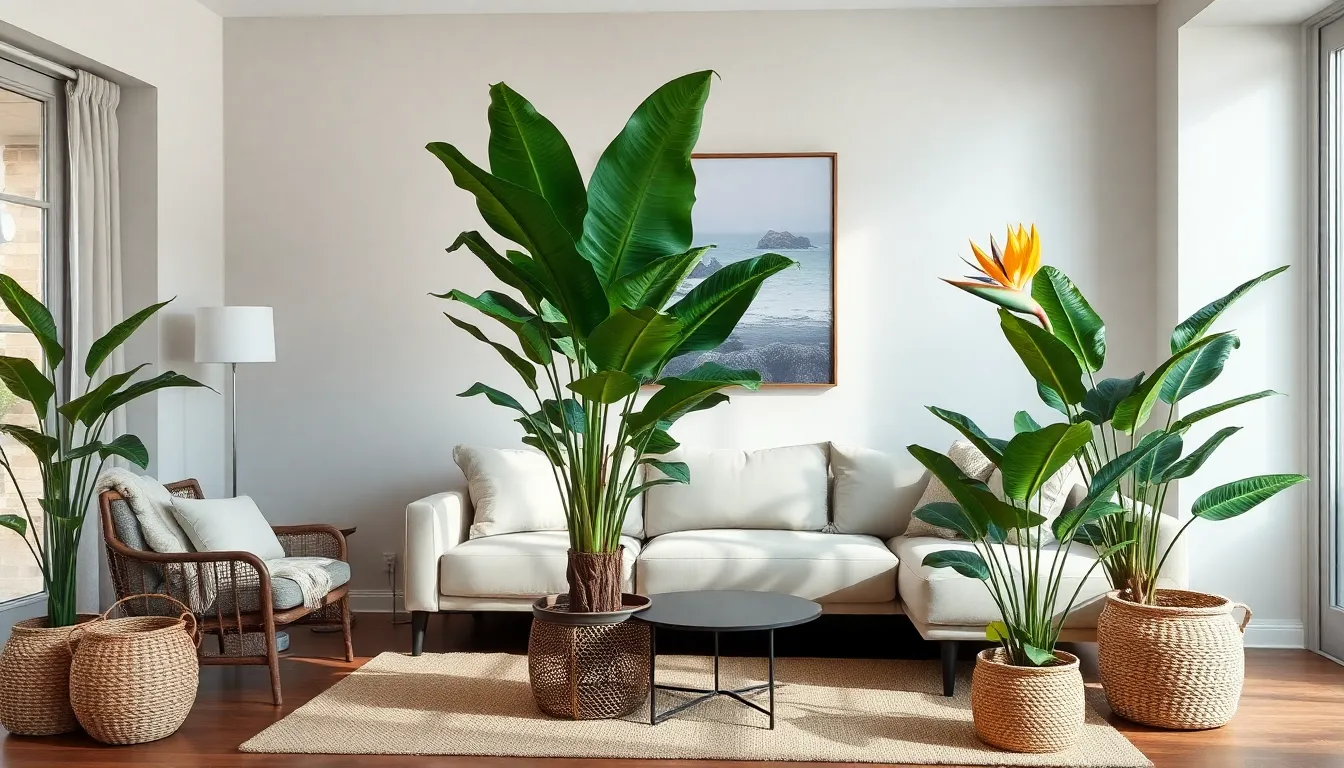
Large potted plants transform our living spaces into stunning, cohesive environments that blend function with natural beauty. Strategic placement and thoughtful arrangement of these impressive plants can completely redefine how we experience our homes.
Create Focal Points in Living Areas
Positioning large indoor plants strategically draws attention and creates natural harmony in our living spaces. Research shows that plants like dracaena, fiddle leaf fig, and bird of paradise work exceptionally well as focal points in open corners, beside large furniture, or near windows where they anchor the room visually.
Placing these statement plants near entryways immediately captures guests’ attention. We can position a tall fiddle leaf fig beside our front door or in the foyer to create an impressive first impression that sets the tone for the entire home.
Using large plants beside sofas or entertainment centers balances furniture proportions. A towering bird of paradise next to our sectional sofa creates visual weight that prevents the seating area from overwhelming the space.
Clustering multiple large plants in odd-numbered groupings enhances visual balance. We can arrange three plants of varying heights in a corner to create depth and movement that naturally guides the eye through the room.
Use Plants as Natural Room Dividers
Large potted plants serve as effective room dividers without blocking sightlines completely. Strategic placement allows us to subtly separate areas while maintaining an open, airy feel throughout our living spaces.
Positioning tall plants between our dining and living areas creates definition without walls. A row of snake plants or dracaenas can establish clear zones while preserving the flow of natural light and conversation.
Using plants with substantial foliage volume maximizes their dividing effectiveness. Monstera deliciosas and rubber plants provide enough visual density to create privacy while adding lush greenery that softens the separation.
Placing plants on wheeled plant stands increases flexibility for room arrangements. We can easily reposition our natural dividers when entertaining or rearranging furniture for different occasions.
Complement Your Interior Design Aesthetic
Large indoor plants add texture, color, and life that suits various design styles from modern minimalism to bohemian or traditional. Their lush greenery softens hard surfaces and balances room proportions while improving our chosen aesthetic.
Selecting plants that match our color palette creates cohesive design flow. Deep green foliage complements neutral tones, while variegated plants like snake plants add visual interest to monochromatic schemes.
Varying plant heights throughout our space creates ever-changing visual rhythm. We can combine floor plants, elevated planters, and hanging varieties to establish layers that add depth and movement to our rooms.
Choosing planters that reflect our design style unifies the overall look. Modern ceramic pots suit contemporary spaces, while woven baskets enhance bohemian or rustic aesthetics, and sleek metal planters complement industrial design.
Conclusion
Large potted plants truly transform our living spaces into vibrant sanctuaries that breathe life into every corner. We’ve covered everything from selecting the perfect specimens to mastering their care routines and styling them beautifully throughout our homes.
The journey of growing large indoor plants isn’t just about decoration—it’s about creating healthier environments while developing rewarding plant care skills. With proper watering techniques moisture monitoring and regular maintenance we can enjoy these stunning green companions for years to come.
Remember that every plant parent’s journey looks different and there’s always room to learn and grow alongside our leafy friends. Start with one statement plant that speaks to you and watch as it transforms both your space and your confidence as an indoor gardener.
Frequently Asked Questions
What are the best locations for large indoor plants?
Place large indoor plants near south or east-facing windows to ensure adequate natural light. Consider ceiling height, floor space, and pot size when selecting locations. Maintain consistent temperature and humidity levels, avoiding drafty areas or spots near heating vents. The location should allow the plant to thrive while complementing your room’s layout and design.
Which large indoor plants are best for beginners?
Fiddle leaf figs, rubber plants, snake plants, and dracaenas are excellent choices for beginners. These varieties are low-maintenance and forgiving, tolerating occasional care lapses while still making dramatic visual statements. They adapt well to various indoor conditions and don’t require extensive gardening experience to maintain successfully.
How often should I water large potted plants?
Large potted plants typically need watering less frequently than smaller plants due to their larger soil volume. Use the finger test or moisture meters to check soil moisture before watering. Generally, water when the top 1-2 inches of soil feel dry. Adjust frequency seasonally, with more frequent watering during spring and summer growth periods.
What type of fertilizer should I use for large indoor plants?
Use balanced, liquid fertilizers for easy absorption, or slow-release fertilizers for consistent nutrition. Organic options are also effective and environmentally friendly. Feed monthly during the growing season (spring and summer) and reduce feeding in winter. Monitor plant responses and adjust fertilizer strength and frequency based on growth patterns and leaf health.
How do I maintain and prune large indoor plants?
Remove dead or yellowing leaves regularly and trim overgrown sections to promote bushier growth. Clean leaves weekly by dusting or gentle wiping to enhance photosynthesis. Rotate plants a quarter turn weekly to ensure even growth and prevent lopsided development. Proper maintenance keeps plants healthy and visually appealing.
What are common problems with large indoor plants and their solutions?
Common issues include pest infestations, yellowing leaves, and root-bound conditions. Inspect regularly for pests like spider mites and aphids, treating with insecticidal soap when needed. Address yellowing leaves by checking soil moisture and light conditions. Repot root-bound plants to encourage healthy growth and prevent stunted development.
How can I style my space with large indoor plants?
Use large plants as focal points beside furniture or near entryways to enhance visual appeal. They can serve as natural room dividers while maintaining an open feel. Vary plant heights for visual rhythm, select planters that complement your interior design, and choose plants that match your aesthetic preferences for cohesive styling.
What pot requirements do large indoor plants need?
Choose pots with adequate drainage holes to prevent waterlogging and root rot. Consider pot material for stability and maintenance needs – heavier materials like ceramic provide better stability for tall plants. Ensure the pot size is appropriate for the plant’s root system and allows for future growth while maintaining proper proportions.

